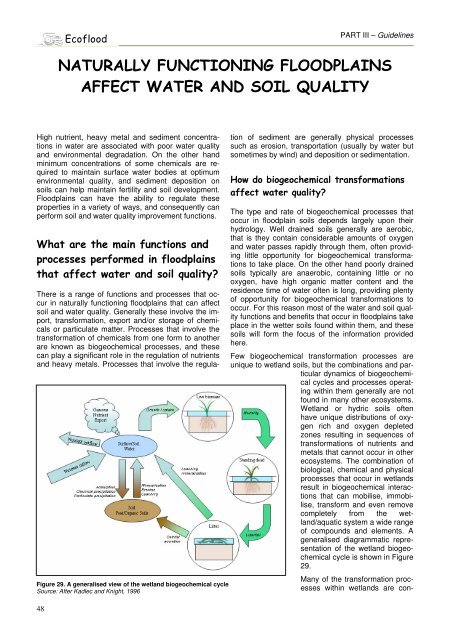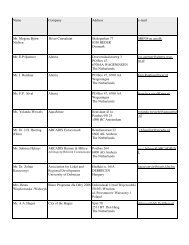HOW TO USE FLOODPLAINS FOR FLOOD RISK ... - SGGW
HOW TO USE FLOODPLAINS FOR FLOOD RISK ... - SGGW
HOW TO USE FLOODPLAINS FOR FLOOD RISK ... - SGGW
You also want an ePaper? Increase the reach of your titles
YUMPU automatically turns print PDFs into web optimized ePapers that Google loves.
48<br />
PART III – Guidelines<br />
" ) $$* 4) " # " " 4$# # & $ "<br />
44% % "& # $ 6 ) $ *<br />
High nutrient, heavy metal and sediment concentrations<br />
in water are associated with poor water quality<br />
and environmental degradation. On the other hand<br />
minimum concentrations of some chemicals are required<br />
to maintain surface water bodies at optimum<br />
environmental quality, and sediment deposition on<br />
soils can help maintain fertility and soil development.<br />
Floodplains can have the ability to regulate these<br />
properties in a variety of ways, and consequently can<br />
perform soil and water quality improvement functions.<br />
/<br />
- - / -<br />
, 0 +<br />
There is a range of functions and processes that occur<br />
in naturally functioning floodplains that can affect<br />
soil and water quality. Generally these involve the import,<br />
transformation, export and/or storage of chemicals<br />
or particulate matter. Processes that involve the<br />
transformation of chemicals from one form to another<br />
are known as biogeochemical processes, and these<br />
can play a significant role in the regulation of nutrients<br />
and heavy metals. Processes that involve the regula-<br />
Figure 29. A generalised view of the wetland biogeochemical cycle<br />
Source: After Kadlec and Knight, 1996<br />
tion of sediment are generally physical processes<br />
such as erosion, transportation (usually by water but<br />
sometimes by wind) and deposition or sedimentation.<br />
. , / /<br />
, 0 +<br />
The type and rate of biogeochemical processes that<br />
occur in floodplain soils depends largely upon their<br />
hydrology. Well drained soils generally are aerobic,<br />
that is they contain considerable amounts of oxygen<br />
and water passes rapidly through them, often providing<br />
little opportunity for biogeochemical transformations<br />
to take place. On the other hand poorly drained<br />
soils typically are anaerobic, containing little or no<br />
oxygen, have high organic matter content and the<br />
residence time of water often is long, providing plenty<br />
of opportunity for biogeochemical transformations to<br />
occur. For this reason most of the water and soil quality<br />
functions and benefits that occur in floodplains take<br />
place in the wetter soils found within them, and these<br />
soils will form the focus of the information provided<br />
here.<br />
Few biogeochemical transformation processes are<br />
unique to wetland soils, but the combinations and particular<br />
dynamics of biogeochemical<br />
cycles and processes operating<br />
within them generally are not<br />
found in many other ecosystems.<br />
Wetland or hydric soils often<br />
have unique distributions of oxygen<br />
rich and oxygen depleted<br />
zones resulting in sequences of<br />
transformations of nutrients and<br />
metals that cannot occur in other<br />
ecosystems. The combination of<br />
biological, chemical and physical<br />
processes that occur in wetlands<br />
result in biogeochemical interactions<br />
that can mobilise, immobilise,<br />
transform and even remove<br />
completely from the wetland/aquatic<br />
system a wide range<br />
of compounds and elements. A<br />
generalised diagrammatic representation<br />
of the wetland biogeochemical<br />
cycle is shown in Figure<br />
29.<br />
Many of the transformation processes<br />
within wetlands are con-




